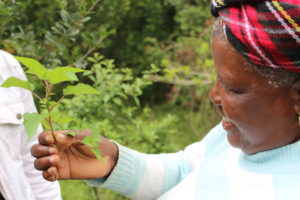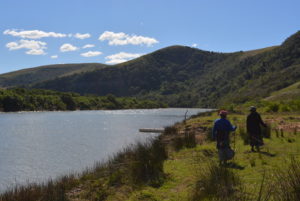
On the occasion of International Day of Rural Women, Dr. Katie Tavenner takes us on a visual journey to Hobeni village with the photobook Women’s hidden harvest: Indigenous vegetables and amaXhosa cultural survival in Hobeni Village, South Africa.
Published by Bioversity International, the book is based on Tavenner’s research on rural women’s struggles to protect their traditional knowledge and harvesting, culinary and spiritual practices attached to imifino, known locally as “women’s vegetables”, in a protected area near the Dwesa-Cwebe Nature Reserve.
Could you tell us how the idea for a photobook was born?
Ever since publishing my dissertation in 2016, I’ve wanted to tell the story of the AmaXhosa women’s struggle for cultural survival in a creative way, so that their experiences in protecting imifino could be more accessible. My research used a participatory photography approach, so telling the story through photographs that could bring the people and places of Hobeni to life seemed like a natural fit.
What is imifino, and what does it mean for the women you met?
Imifino is the IsiXhosa word used to describe green leafy vegetables that grow wild in forests, and in fallowed and cultivated fields. Considered weeds in many parts of the world, in Hobeni village imifino play an important nutritional role as a free and healthy food source. Imifino are special to women, who guard the traditional knowledge on plant identification, harvesting, and use in culinary traditions.
These plants also have importance in female cultural rites of passage. When young girls can independently collect imifino from the forest, they become women. Imifino knowledge and traditions came under threat when colonial and then apartheid authorities imposed a ban on harvesting natural resources from the nearby forest. Anyone caught harvesting inside the forest under the ban could be charged fines, taken to jail, and abused and harassed by park rangers. Remarkably, traditional imifino knowledge has endured through the stories, actions, and resistance of local women.
You mention comanagement. Is it possible to protect these forest areas while acknowledging women’s traditions?
For more than a century, colonial and apartheid-era governments forcibly removed Hobeni residents from the forest in the name of ‘environmental protection’. The communities won a land claim battle over the forest in 2001 and a comanagement forestry agreement was signed. It has, however, not been implemented and recent attempts by the parks board and local community to enter into a comanagement agreement have not been successful due to disagreements and delays. A wire fence still surrounds the forest, and local people do not have secure access rights to resources, including a variety of forest foods.
To protect the sociocultural heritage around imifino, there needs to be a shift in the conservationist thinking of authorities and equitable relations between them and the communities who use local natural resources must be established. Management should respect the AmaXhosa system of resource use and integrate women’s indigenous knowledge into forest management plans, because allowing forest harvesting can restore the full cycle of plant knowledge and use. The park rangers and local management I spoke with are ready and helpful, but leadership is needed at the national-level management system to legally uphold the prioritization of sociocultural traditions in environmental protection.
What would you like for the readers of this book to be the most important take-away message?

Imifino are an important forest food resource for the Hobeni community that provides special connections between young and old women and their traditional AmaXhosa culture – connections that are in grave danger of being broken forever if access rights are not secured long-term.
Denied access to natural resources at the Dwesa-Cwebe Nature Reserve means grave cultural, economic, and spiritual losses for the Hobeni community. The erosion of women’s local ecological knowledge of forest foods has resulted in lower rates of consumption and availability for rituals and cultural practices.
As a cultural symbol of a girl’s journey to womanhood, a traditional culinary dish, and a nutritional resource, the continued use of imifino is critical to maintaining the system of indigenous knowledge bound to the resource. Now is the time to recognize women’s knowledge in the management of plant biodiversity to ensure this cycle endures.
Read also: Restoration initiatives must consider how gender relations shape control over land
Are you hopeful for positive change for the women and girls in Hobeni village?
The cultural survival of the traditions surrounding imifino is now in the hands of a few dedicated and resilient elderly experts. However, there is not much time left: Immediate interventions supported by national-level conservation bodies and local NGOs are needed to ensure these cultural traditions and the associated knowledge system will not disappear forever. This book is a testament to Hobeni women’s and girls’ strength in keeping their traditions alive despite considerable challenges. These women will continue to actively protest and resist current management policies at great personal risk and fight laws that deny their cultural rights and responsibilities. It is my hope that this book spreads their message to a wider audience, and that their message is received and heeded by those in power.
By Giulia Micheletti, Bioversity International.
This work forms part of the CGIAR Research Program on Forests, Trees and Agroforestry, which is supported by the CGIAR Trust Fund.











